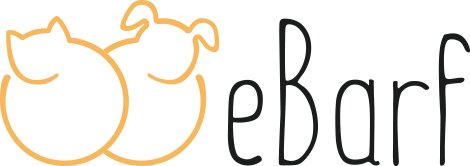Industrial Cat Food - Pros, Cons, and Why Raw Feeding is a True Alternative
Dear Readers,
let’s first take a look at industrially manufactured cat food. Supermarket and pet store shelves are packed with countless types of food. The price differences can be enormous: an 80g can might cost almost €2. However, price is not necessarily an indicator of high-quality food.
The declaration options for pet food are so broad that pet owners cannot determine the exact ingredients. Labels on cans or packaging often list terms such as:
- Meat and animal by-products
- Fish by-products
- Hydrolyzed meat
- Fish and meat meals (e.g., chicken meat meal or chicken meal)
- Eggs and egg products
- Grains, cellulose, cereals, bran, gluten, bakery by-products, etc.
- Plant by-products
- Plant protein extracts
- Oils and fats
- Sugar
- Beet pulp
- Over 400 flavorings, enzymes, and other substances that are not required to be declared
The following excerpt from the EU regulation clarifies what type of "animal by-products" this term covers.
REGULATION (EC) No. 1774/2002 OF THE EUROPEAN PARLIAMENT AND OF THE COUNCIL of 3 October 2002 laying down health rules concerning animal by-products not intended for human consumption
SUMMARY
Animal by-products are defined as whole animal bodies, parts of animal bodies, or products of animal origin not intended for human consumption, including eggs, embryos, and semen. This includes over 15 million tons of meat, dairy products, and other materials, including manure. This material is then destroyed or processed for reuse in various sectors, including the cosmetics or pharmaceutical industries, or for other technical purposes.
CATEGORIES OF ANIMAL BY-PRODUCTS
Category 3 Material
Category 3 material includes the following animal by-products:
- Parts of carcasses that are fit for consumption but are not intended for human consumption for commercial reasons;
- Parts of carcasses rejected as unfit for consumption but showing no signs of transmissible disease;
- Hides, hooves, and horns, bristles, and feathers from animals slaughtered in an approved slaughterhouse following inspection for human consumption;
- Blood from animals other than ruminants slaughtered in a slaughterhouse following inspection for human consumption;
- Animal by-products arising from the production of products for human consumption, including defatted bones and greaves;
- Former foodstuffs of animal origin, excluding catering waste, unfit for human consumption due to commercial or manufacturing issues;
- Raw milk from animals showing no signs of transmissible disease;
- Fish or other marine animals, excluding marine mammals, caught at sea for fishmeal production, and fresh by-products from fish processing plants producing products for human consumption;
- Egg shells from animals showing no signs of transmissible disease;
- Blood, hides, hooves, feathers, wool, horns, hair, and fur from healthy animals;
- Other catering waste not categorized as Category 1 (e.g., catering waste from cross-border transport vehicles).
Category 3 material must be handled, transported, labeled, and:
- Directly disposed of as waste through incineration in an approved facility;
- Used as raw material in approved pet food plants;
- Processed in approved facilities using specific processing methods, technical plants, or in biogas/composting facilities;
- Processed in biogas or composting facilities in the case of catering waste;
- Silaged or composted in the case of fish material.
Animal By-Products & Grains in Commercial Pet Food
Category 3 raw materials refer to meat and by-products from the slaughter of animals approved for human consumption. Animal by-products can indeed be high-quality ingredients, such as offal like liver, stomach, heart, lungs, spleen, and kidneys. However, these are usually listed separately on the label, as manufacturers use them to advertise their high-quality food.
The trade in so-called slaughter by-products is booming. Consumers have no way of knowing how much of their purchased pet food consists of claws, feathers, intestines, bladder, reproductive organs, blood vessels, and more. Manufacturers argue that animals in the wild consume the entire prey and don’t discard the by-products. This is true. But: the quantity makes the difference!
Many cat foods contain a high percentage of grains, with up to 60% found in dry food. Although cats can tolerate digestible carbohydrates in larger amounts, it places additional stress on their digestion and organs, which are not designed for it. Cats lack the necessary enzymes to break down carbohydrates. Their bodies and metabolic processes are specifically adapted for high protein utilization. While cats can digest large amounts of carbohydrates, this doesn’t mean it is healthy for them. Their organs are overburdened, and the intake of animal proteins is too low to meet their amino acid, vitamin, and mineral requirements.
This leads to diabetes, pancreatic issues, gastrointestinal diseases, allergies, obesity, and more. The term "grains" can include all conceivable types of grains or mixtures thereof. Often, corn and soy products are used, which recent studies have identified as the #1 cause of allergies in cats suffering from food allergies.
Unnecessary Additives in Industrial Cat Food
Sugar is a common tool used to enhance flavor and improve the appearance of cooked meat, which often turns gray during cooking and is caramelized to become a pleasing brown. Sugar comes in many names: sucrose, dextrose, glucose, fructose, molasses, beet pulp, caramel, cellulose, maltose, and more. Labels might also include the vague term: bakery by-products, which often refers to sweet baked goods that are no longer sellable.
Unfortunately, plant by-products frequently include industrial waste. For example, peanut shells are a commonly used plant filler. Other examples include cellulose of unknown origin (e.g., from wood waste or cotton), straw, brewery waste, or starch production residues (e.g., corn gluten meal). All of these can cause or exacerbate allergies. Many of these ingredients lead to gastrointestinal disturbances, such as pain, bloating, and diarrhea.
Oils and fats used in pet food manufacturing are often not the pure fats we know. Instead, they are waste fats, such as old frying oil and other food industry residues. These are first processed for technical purposes as legally required, where fatty acids are extracted and reintroduced into the pet food manufacturing cycle.
In addition to the mentioned ingredients, there are countless additives, including minerals, vitamins, preservatives, colorings, flavor enhancers, aromas, and fatty acids—most of which are chemical in nature.
Dangerously Low Water Content in Dry Food
While wet food contains 70–80% water, the water content in dry food is much lower, typically 8–10%. Over time, this can have severe consequences for the kidneys, urinary tract, and cardiovascular system. Cats fed dry food never consume enough additional water to compensate for their needs because, unlike humans, they lack a natural sense of thirst.
As a result, cats are permanently dehydrated. This leads to more concentrated urine, reduced toxin elimination, impaired kidney function, poor nutrient absorption in the intestines, and frequent constipation with very hard stools. Cats often develop urinary stones after prolonged feeding with dry food. A four-kilogram cat fed dry food would need to consume 200–250 ml of water daily. Have you ever seen a cat drink such a large amount unless it has diabetes or chronic kidney disease?
Processing Destroys Nutrients in Commercial Pet Food
Worse still, the nutrients that cats could still utilize from the natural components of the food are largely destroyed during manufacturing processes. These include heating to 180 °C, breaking down components into their individual parts, hydrolysis (a chemical reaction with water), and the addition of preservatives and other processing aids.
It becomes especially challenging for cat owners when their pet is chronically ill, for example, with kidney failure, pancreatitis, or allergies. Typically, the veterinarian prescribes special diet food—often in the form of dry food. For instance, Royal Canin has developed an entire industry around hydrolyzed chicken protein. While it may seem like a good idea to feed animal protein, the reality is quite different. These proteins are derived from chicken feathers and sold to cat owners at a premium. Waste products are thus marketed as "high-quality proteins," supposedly ideal for allergic cats. No further explanation is needed, I think.
How to Recognize High-Quality Commercial Cat Food
- Do not buy cat food from supermarkets, as they only offer low-quality options.
- Ingredients should be clearly listed, such as beef, liver, heart, etc.
- Ensure the food contains a high meat content, at least 80%.
- Carbohydrates (sugar, grains, rice, etc.) have no place in cat food.
- The less food needed per day, the higher the quality of the product.
- There should be no preservatives, colorants, flavorings, or fillers included.
- Avoid dry food! Cats are desert animals with a poorly developed sense of thirst, meaning they will never drink enough water to compensate for the lack caused by dry food. Kidney damage is often a result of feeding dry food.
- Try our gently cooked Fix-BAF complete menus, which are made from 100% high-quality and appropriate ingredients, tailored to individual needs.
Want to avoid all these issues and provide your pet with healthy nutrition? Then switch to BARF now. We’re happy to assist you with the transition—just reach out to us at info@ebarf.com.
For more information and tips, check out our book recommendation Katzen BARFen. Additionally, in our online shop, you’ll find a high-quality complete food, frozen for freshness: Fix-BARF® in various flavors, and even options for chronically ill cats!
If you have questions about raw feeding or Fix-BARF products, feel free to contact me at petra.von.quillfeldt@ebarf.com.
Yours, Petra von Quillfeldt






















0 Kommentare